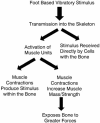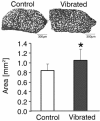Is bone formation induced by high-frequency mechanical signals modulated by muscle activity?
- PMID: 20190375
- PMCID: PMC2919567
Is bone formation induced by high-frequency mechanical signals modulated by muscle activity?
Abstract
Bone formation and resorption are sensitive to both external loads arising from gravitational loading as well to internal loads generated by muscular activity. The question as to which of the two sources provides the dominant stimulus for bone homeostasis and new bone accretion is arguably tied to the specific type of activity and anatomical site but it is often assumed that, because of their purportedly greater magnitude, muscle loads modulate changes in bone morphology. High-frequency mechanical signals may provide benefits at low- (<1g) and high- (>1g) acceleration magnitudes. While the mechanisms by which cells perceive high-frequency signals are largely unknown, higher magnitude vibrations can cause large muscle loads and may therefore be sensed by pathways similar to those associated with exercise. Here, we review experimental data to examine whether vibrations applied at very low magnitudes may be sensed directly by transmittance of the signal through the skeleton or whether muscle activity modulates, and perhaps amplifies, the externally applied mechanical stimulus. Current data indicate that the anabolic and anti-catabolic effects of whole body vibrations on the skeleton are unlikely to require muscular activity to become effective. Even high-frequency signals that induce bone matrix deformations of far less than five microstrain can promote bone formation in the absence of muscular activity. This independence of cells on large strains suggests that mechanical interventions can be designed that are both safe and effective.
Figures




Similar articles
-
Dynamic skeletal muscle stimulation and its potential in bone adaptation.J Musculoskelet Neuronal Interact. 2010 Mar;10(1):12-24. J Musculoskelet Neuronal Interact. 2010. PMID: 20190376 Free PMC article. Review.
-
Low-level, high-frequency mechanical signals enhance musculoskeletal development of young women with low BMD.J Bone Miner Res. 2006 Sep;21(9):1464-74. doi: 10.1359/jbmr.060612. J Bone Miner Res. 2006. PMID: 16939405 Clinical Trial.
-
Low-magnitude mechanical signals that stimulate bone formation in the ovariectomized rat are dependent on the applied frequency but not on the strain magnitude.J Biomech. 2007;40(6):1333-9. doi: 10.1016/j.jbiomech.2006.05.014. Epub 2006 Jun 30. J Biomech. 2007. PMID: 16814792
-
Regulation of mechanical signals in bone.Orthod Craniofac Res. 2009 May;12(2):94-104. doi: 10.1111/j.1601-6343.2009.01442.x. Orthod Craniofac Res. 2009. PMID: 19419452 Review.
-
Low-level mechanical vibrations can influence bone resorption and bone formation in the growing skeleton.Bone. 2006 Nov;39(5):1059-1066. doi: 10.1016/j.bone.2006.05.012. Epub 2006 Jul 7. Bone. 2006. PMID: 16824816
Cited by
-
The effect of whole body vibration therapy on bone density in patients with thalassemia: a pilot study.Am J Hematol. 2012 Oct;87(10):E76-9. doi: 10.1002/ajh.23305. Epub 2012 Aug 7. Am J Hematol. 2012. PMID: 22886910 Free PMC article. Clinical Trial.
-
Combating osteoporosis and obesity with exercise: leveraging cell mechanosensitivity.Nat Rev Endocrinol. 2019 Jun;15(6):339-355. doi: 10.1038/s41574-019-0170-1. Nat Rev Endocrinol. 2019. PMID: 30814687 Free PMC article. Review.
-
Finite-element modeling of viscoelastic cells during high-frequency cyclic strain.J Funct Biomater. 2012 Mar 22;3(1):209-24. doi: 10.3390/jfb3010209. J Funct Biomater. 2012. PMID: 24956525 Free PMC article.
-
Effects of whole-body vibration on acute bone turnover marker responses to resistance exercise in young men.J Musculoskelet Neuronal Interact. 2015 Mar;15(1):23-31. J Musculoskelet Neuronal Interact. 2015. PMID: 25730649 Free PMC article. Clinical Trial.
-
Reduced gravitational loading does not account for the skeletal effect of botulinum toxin-induced muscle inhibition suggesting a direct effect of muscle on bone.Bone. 2013 May;54(1):98-105. doi: 10.1016/j.bone.2013.01.043. Epub 2013 Feb 4. Bone. 2013. PMID: 23388417 Free PMC article.
References
-
- Christiansen BA. Whole-body vibration and weight loss: truth or consequence? Int J Obes (Lond) 2009;33:384–3. - PubMed
-
- Verschueren SM, Roelants M, Delecluse C, Swinnen S, Vanderschueren D, Boonen S. Effect of 6-month whole body vibration training on hip density, muscle strength, and postural control in postmenopausal women: a randomized controlled pilot study. J Bone Miner Res. 2004;19:352–9. - PubMed
-
- Abercromby AF, Amonette WE, Layne CS, McFarlin BK, Hinman MR, Paloski WH. Vibration exposure and bio-dynamic responses during whole-body vibration training. Med Sci Sports Exerc. 2007;39:1794–800. - PubMed
-
- Bernard B, Nelson N, Estill CF, Fine L. The NIOSH review of hand-arm vibration syndrome: vigilance is crucial. National Institute of Occupational Safety and Health. J Occup Environ Med. 1998;40:780–5. - PubMed
